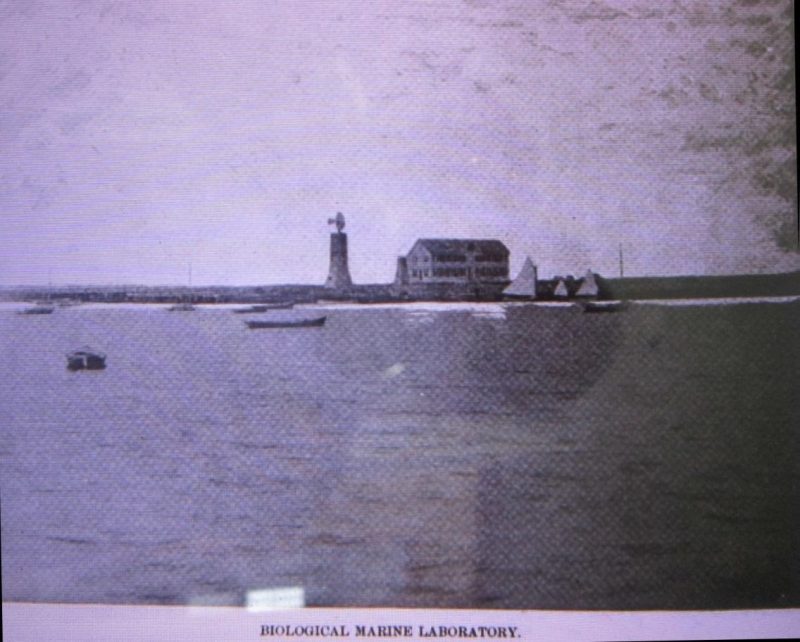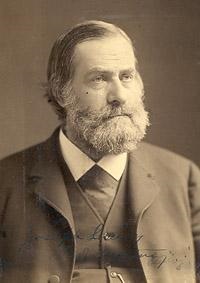Dr. Joseph Leidy was the director of the biology department.
 by Bob Thibault
From the Cape May County Times, February 26, 1892:
by Bob Thibault
From the Cape May County Times, February 26, 1892:
“The University of Pennsylvania has located its biological department in Sea Isle City, being the only institution of its kind in America. Many visitors of a scientific bent of mind will undoubtedly be attracted to the spacious aquarium, where may be seen one of the most instructive exhibits in the world of the wonders of the deep.”
This may have been a slight exaggeration. Penn’s biology department never considered relocating from Philadelphia, and the Sea Isle lab was actually the sixth of its kind in the United States. But its attributes were sufficiently unique to make it one of the best of its time and, while it lasted, the hub of marine science in the Middle Atlantic States.
A little background
In the early 1880s, at the same time that Charles K. Landis was getting started in Sea Isle, the University of Pennsylvania decided to establish a Department of Biology with distinguished Professor Joseph Leidy, M.D., as its director. As the decade progressed, Dr. Leidy and his staff became convinced that hands-on research was the best approach to fill the needs of both students and faculty, especially in the area of marine biology. A research facility was needed in a locale where the widest possible variety of specimens could be observed, harvested, examined, and displayed in their natural environment.
In 1889, the search was on to find a suitable home for the newly named University of Pennsylvania Laboratory of Marine Biology.
Why choose Sea Isle?
To read the glowing rationale given for selecting Sea Isle City as the ideal site for the new laboratory would make an oysterman blush. Here are some excerpts:
- “The fauna of the New Jersey shore waters and of its numerous bays and thoroughfares is exceedingly rich.”
- “Sea Isle City...affords unsurpassed facilities for the utilization of this rich field for investigation.”
- “It has good harborage for (specimen) collecting boats.”
- “(It has) Ludlam Bay with its oyster grounds of thousands of acres.”
- “Sea Isle City is located in an area...which shelves in the most gradual manner for a distance of several miles to sea.”
- “It is underlaid with a hard, black earth, representing submerged meadow land which forms a favorite habitat for mollusks of great number and variety.”
- “It has direct railroad connection with New York and Philadelphia by numerous fast trains.”
- “A steam tramway affords facilities for reaching any point on the beach.”
- “There are no unpleasant surroundings and living expenses are very moderate.”
It also didn’t hurt that Charles Landis offered to donate five acres of land on Ludlam Bay for the project, and to subsidize the construction of the facility and some of the major equipment. How could Dr. Leidy and his team turn that down? In 1891, Sea Isle City was named the official site for the new Penn Laboratory of Marine Biology.
The Laboratory becomes a reality
When completed in 1891, the Sea Isle lab was housed in a two story, 24-foot by 72-foot building, with the entire first level devoted to a series of 25 flowing salt water aquariums for displaying marine life (with the public invited). The remainder of the space provided experimental research stations and areas for teaching. The facility was equipped with a private dock, a barge, dredges, trawls, six row boats – and three sailboats.
Renowned scientists from the University of Pennsylvania and elsewhere came to work and teach in Sea Isle. The laboratory was capable of accommodating 16 investigators and 20 students. An announcement of summer courses for 1892 lists studies in marine botany, zoology, microscope techniques, and advanced research at a cost of $25.00 each, payable in advance.
But this seemingly ideal situation lasted for just a few short years. It’s unfortunate that Joseph Leidy, who had spearheaded the project, died in 1891 before the facility became fully operational. Perhaps he could have saved it.
What happened?
Simply put, the money ran out. Charles Landis had been generous, but the laboratory operated largely independent of the university as a funding source. Further monies were needed. Private donations were solicited, as were bequests with the stipulation (according to Pennsylvania law) that any bequest had to be made at least one calendar month before the death of the donor – so it appeared some clairvoyance was required. For the living, memberships were offered at $5 a year. For $500, one could become a “Founder” (about $13,900 in today’s dollars).
But even with all this, the laboratory proved to be too costly to maintain. Potential donors became uninterested in purely scientific endeavors, and university officials were not prepared to continue any funding after private support ceased. Advanced students and faculty shifted their activities to the well-equipped and heavily endowed Marine Biological Laboratory at Wood’s Hole on Cape Cod.
It’s not clear just how long the Sea Isle lab existed – anywhere from a few years to a decade, most likely the former. Nor is it clear what happened to the building and all of its equipment, boats, etc. One thing is clear: for the short time it lasted, the Sea Isle City Laboratory of Marine Biology was a top-notch center of research. To those who worked there, it was a scientific Camelot.
A Testimonial
Dr. John Muirhead MacFarlane, Professor of Botany at the Royal Veterinary College of Edinburgh, after spending a summer in Sea Isle, later wrote the following:
“The Sea Isle Laboratory of the University of Pennsylvania is now a demolished reality, a living memory, a material shadow. But all who participated in the joys of its existence, through the summer of 1892, will never allow it to suffer mental decay.”
To learn more about this fascinating era in our City’s history, please visit the Sea Isle City Historical Museum at 48th Street and Central Avenue. Access the website at www.seaislemuseum.com . Call 609-263-2992 with any questions. The Museum’s current hours are 10 a.m. to 3 p.m. on Monday, Tuesday, Thursday, and Friday.

Dr. Joseph Leidy was the director of the biology department.
 by Bob Thibault
From the Cape May County Times, February 26, 1892:
“The University of Pennsylvania has located its biological department in Sea Isle City, being the only institution of its kind in America. Many visitors of a scientific bent of mind will undoubtedly be attracted to the spacious aquarium, where may be seen one of the most instructive exhibits in the world of the wonders of the deep.”
This may have been a slight exaggeration. Penn’s biology department never considered relocating from Philadelphia, and the Sea Isle lab was actually the sixth of its kind in the United States. But its attributes were sufficiently unique to make it one of the best of its time and, while it lasted, the hub of marine science in the Middle Atlantic States.
A little background
In the early 1880s, at the same time that Charles K. Landis was getting started in Sea Isle, the University of Pennsylvania decided to establish a Department of Biology with distinguished Professor Joseph Leidy, M.D., as its director. As the decade progressed, Dr. Leidy and his staff became convinced that hands-on research was the best approach to fill the needs of both students and faculty, especially in the area of marine biology. A research facility was needed in a locale where the widest possible variety of specimens could be observed, harvested, examined, and displayed in their natural environment.
In 1889, the search was on to find a suitable home for the newly named University of Pennsylvania Laboratory of Marine Biology.
Why choose Sea Isle?
To read the glowing rationale given for selecting Sea Isle City as the ideal site for the new laboratory would make an oysterman blush. Here are some excerpts:
by Bob Thibault
From the Cape May County Times, February 26, 1892:
“The University of Pennsylvania has located its biological department in Sea Isle City, being the only institution of its kind in America. Many visitors of a scientific bent of mind will undoubtedly be attracted to the spacious aquarium, where may be seen one of the most instructive exhibits in the world of the wonders of the deep.”
This may have been a slight exaggeration. Penn’s biology department never considered relocating from Philadelphia, and the Sea Isle lab was actually the sixth of its kind in the United States. But its attributes were sufficiently unique to make it one of the best of its time and, while it lasted, the hub of marine science in the Middle Atlantic States.
A little background
In the early 1880s, at the same time that Charles K. Landis was getting started in Sea Isle, the University of Pennsylvania decided to establish a Department of Biology with distinguished Professor Joseph Leidy, M.D., as its director. As the decade progressed, Dr. Leidy and his staff became convinced that hands-on research was the best approach to fill the needs of both students and faculty, especially in the area of marine biology. A research facility was needed in a locale where the widest possible variety of specimens could be observed, harvested, examined, and displayed in their natural environment.
In 1889, the search was on to find a suitable home for the newly named University of Pennsylvania Laboratory of Marine Biology.
Why choose Sea Isle?
To read the glowing rationale given for selecting Sea Isle City as the ideal site for the new laboratory would make an oysterman blush. Here are some excerpts:
 Dr. Joseph Leidy was the director of the biology department.
Dr. Joseph Leidy was the director of the biology department.